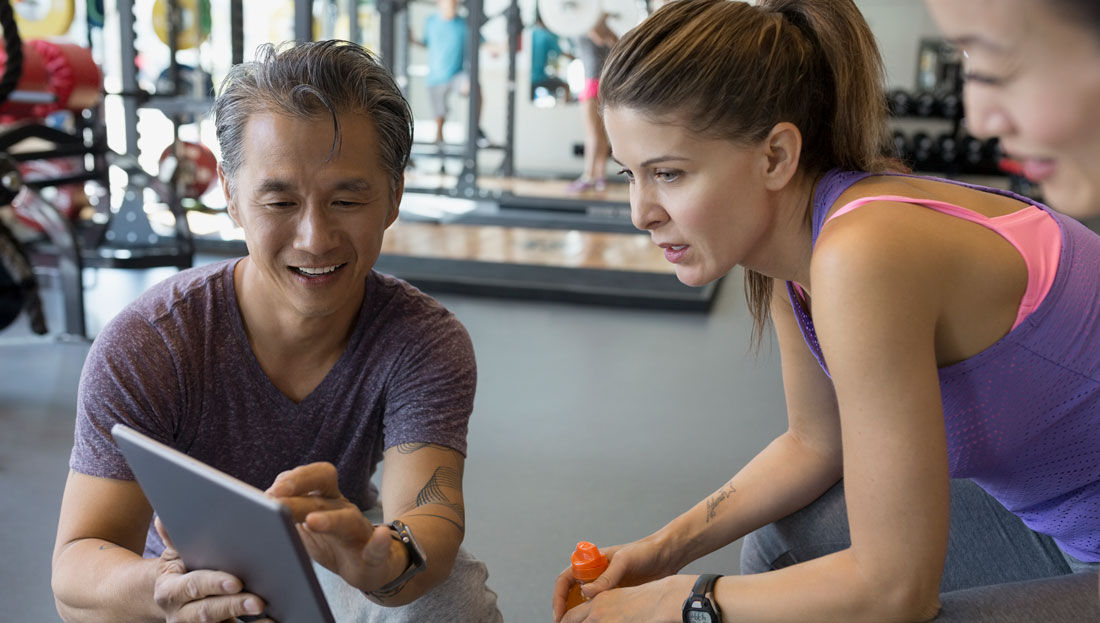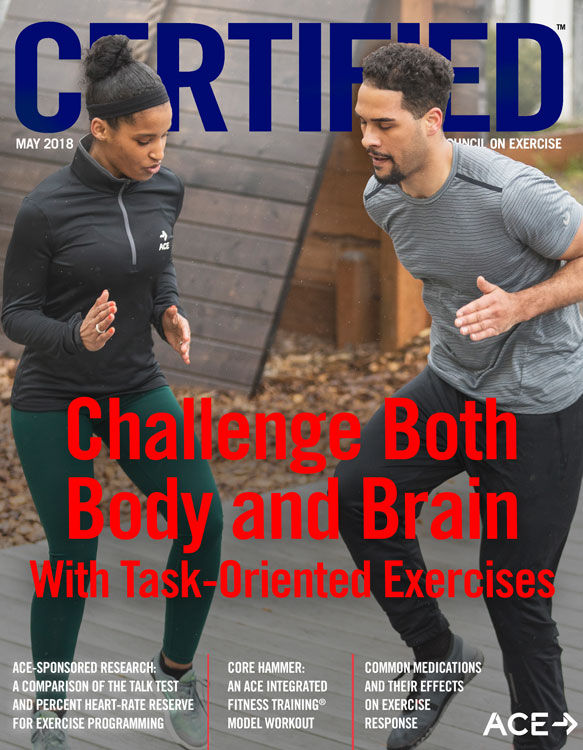
In college, as a freshly certified group fitness instructor, I became known as a local fitness guru at my college gym. Class participants wanted to know, “What do you eat?” or “What’s your workout routine like?” Despite these interactions, I didn’t feel like an expert. In fact, I felt overwhelming self-doubt.
“Do I know enough?”
“Am I fit enough?”
An undercurrent of unworthiness ran through all of my professional interactions. No matter what I did, I couldn’t shake the feeling that this “fit girl” was a fraud.
Many years and conversations with other health and exercise professionals later, I’ve realized this feeling is normal—we all feel like fitness frauds sometimes. This article explores these uncomfortable feelings and highlights the strategies other health and exercise professionals have used to overcome them.
Do I Know Enough?
As fitness and nutrition information continue to evolve, you may begin to question your position as a fitness expert.
“I find that the more I learn, the more I question my previous knowledge,” says Theresa Perales, M.S., a group fitness instructor in San Diego, Calif. “I may learn things that sound contradictory to concepts previously learned or take a class with another trainer, and something as simple as their terminology or the way they cue makes me question my level of knowledge and/or skillset.”
These feelings of inadequacy can be crippling. Rather than becoming frustrated with yourself or indulging in negative comparisons, consider how you might use the situation to improve your skillset and enhance your career.
“I find that doubt creeps in when I try to make things more complicated than they need to be or when I’m presented with a client or problem that is outside of my area of expertise, and my ego doesn’t want to admit it,” says Molly Galbraith, co-founder of Girls Gone Strong and creator of the Coaching and Training Women Academy. “Over the years I’ve recognized the power of “staying in my lane” and not being afraid to admit when I don’t know something.”
As professionals, we often desire to be all and know all for our clients. However, there’s power in referring a client to someone with deeper knowledge of a certain area or simply saying, “I don’t know. I’ll find out and get back to you.”
Adopting a growth mindset can help eradicate the fear of not knowing enough.
“After other instructors take my class, I ask for feedback,” says Perales. “They may not always [offer] something I want to hear, but there is indubitably something I can learn.” By intentionally creating regular opportunities for feedback, you can foster a growth mindset, which will enhance your impact as a health and exercise professional.
Am I Fit Enough?
The pressures to live up to certain aesthetic ideals as a health and exercise professional are enormous. Many imagine personal trainers to be muscular, strong and lean, and not living up to these ideals causes many trainers to wonder, “Am I fit enough to work in this industry?”
David Rodriguez, a San Diego-based personal trainer, knows the pain of struggling with body image. “I used to weigh over 300 pounds,” he says, “with a waist size and body-fat percentage that shared the same number: 42.” He explains that, growing up with obesity, he grappled with the harsh social stigma that often accompanies it. “One day I got tired of it and decided to change,” he says. “Over the next couple years I lost over 100 pounds, but that doubt and constant self-criticism never left.”
The weight loss reignited Rodriguez’ love of soccer, and he eventually went on to join the San Diego Sockers Reserve team, playing professional indoor soccer for two years. Despite his successes, his body consciousness didn’t subside. “I could never bring myself to change in the locker room,” he says. “I would always change in the bathroom or show up ready to go.”
Rodriguez isn’t alone in his struggles with body image.
“I used to feel pressure to live up to an unsustainable (for me) physical ideal as a fitness professional,” says Galbraith. “As someone with Hashimoto’s [autoimmune hypothyroidism] and PCOS [polycystic ovarian syndrome], maintaining a very low body-fat percentage is not healthy for me physically or emotionally. I used to feel very self-conscious about it and put myself through years of extreme diet and exercise regimens in an attempt to force my body to achieve a level of leanness that wasn’t healthy for me. I thought that how my body looked was a direct representation of my abilities as a coach and trainer.” Many health and exercise professionals deal with similar issues, feeling that their bodies are a depiction of their skill and expertise, a challenge invoked by few other professions.
“Around 2013, I decided that I would embrace my body as it is,” says Galbraith. “It’s taken years of work, but now I’m at a point where I believe my body isn’t tied to my worthiness, my knowledge or my abilities as a coach and trainer.”
The pervasiveness of body-image issues spans both health and exercise professionals and non-professionals alike. As such, we are in a unique position to use our body-image concerns for good.
“A lot of clients deal with body-image issues and many of them are too scared or embarrassed to talk about them, because saying things out loud makes them real,” says Rodriguez. “Sharing your own feelings of self-doubt and insecurity signals to the client that it’s normal to have these feelings and that you’re someone who can relate.”
Body consciousness won’t abate over night, but you can begin to work with these feelings by sharing them and by taking an honest look at what your thoughts, words and actions convey to yourself, and others, about what it means to have a fit body.
Positive Body Scan
A body scan is a mindfulness tool both you and your clients can use to create more positive feelings about the body and to improve body image. It involves scanning through each area of your body, from your toes to your head, with open and non-judgmental awareness.
Lie down and take a few minutes to slowly scan through your body. As you move through each area, notice the physical sensations present and the thoughts and feelings that arise. When you come to an area that is particularly emotionally charged, just notice it, without trying to push it away. Then see if you can find something positive or redeeming about this area. For example, if your stomach is an area of concern, consider, “Is there anything I like about this area? Anything that it does for me?” You might reflect that it houses the organs that digest your food, keeps you upright, and allows you to engage in the activities you love.
For a guided body scan, see the Compassionate Body Scan at www.selfcompassion.org.
What if My Behavior and Profession Don’t Line Up?
Clients, friends and family members often expect you to be perfect, righteous and unwavering in your pursuit of health and fitness. Reaching for an extra slice of bread during a family dinner can invoke unwelcome comments about your adherence to current nutritional trends. You may wind up feeling like anything that falls outside of culturally promoted ideas of “healthy behavior” is up for scrutiny. Social media, with its incessant barrage of #cleaneating, only adds fuel to the fire.
These instances can incite cognitive dissonance, the internal strife that occurs when one’s behaviors don’t align with their values or ideals. Any time a workout is skipped or a treat is eaten, internal voices pipe up, attacking us with their “shoulds” and “shouldn’ts” and incite feelings of being a “fitness fraud.”
There are two ways to respond to cognitive dissonance: change your behavior or change your belief. For example, if going out for pizza and ice cream with friends on Friday night results in extreme feelings of guilt, you can either change the behavior (stop going to pizza with friends) or change your belief (consider whether the occasional slice of pizza is truly an unforgivable sin). You’re empowered to choose the option that works best for you, personally. Will changing your social eating habits make you a healthier and happier person, or is adjusting your viewpoint to allow for some fun foods a more health-enhancing strategy?
In deviating from the cultural norm of what it means to behave “like a personal trainer,” you actually enhance your impact on those you serve.
“I try to be transparent with clients and let them know when I’ve indulged in some wine or treats,” says Perales. “I want them to know that I’m human, and this openness helps me build relationships with clients outside of the fitness environment.”
For clients who come to trainers with less-than-stellar health behaviors, the client-trainer relationship can provoke anxiety. Letting clients know that a healthy lifestyle includes a wide range of foods and activities and varies widely from one individual to the next decreases pressure and allows clients to explore what work best for them. This increases the likelihood of clients sticking with healthy behaviors long-term.
“My job isn’t to police what my clients eat,” says Rodriguez. “But rather, to help them understand what happens when they eat certain foods so they can make informed choices.”
In sharing situations with clients in which we are less than perfect, we remove the notion that perfection is the goal (and that it’s the only way to achieve desired results). In doing so, we free our clients to make personal choices regarding what’s best for their own health and well-being. This, in turn, increases confidence and sustainability in maintaining healthy behaviors.
“I recognized how valuable is it that we show our clients that “healthy” comes in a wide variety of shapes, sizes and ability levels,” says Galbraith. “It makes good health feel more attainable and accessible to everyone, when a “healthy body” is no longer defined in such a narrow context.”
Use Your Struggles for Good
Being a health and exercise professional comes with increased demands to act and look a certain way, and many trainers bear the burden of feeling they don’t measure up. By acknowledging, sharing and working through these feelings, we can ease our fears and enhance our client impact.
“Insecurity and self-doubt are feelings everyone has experienced,” says Rodriguez. “Being able to talk about them without stigma can create a better community for both exercise professionals and the individuals who come to us for help.”





 by
by 


